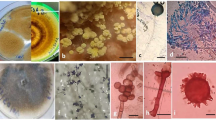Abstract
Certain plant growth–promoting bacteria, such as Pseudomonas fluorescens 89B61 and Bacillus pumilus SE34, secreted high levels of indole-3-acetic acid (IAA) in tryptophan-amended medium in stationary phase as determined by chromogenic analysis and high-performance liquid chromatography. Two other growth-promoting strains, P. chlororaphis O6 and Serratia marcescens 90-166, did not produce these high levels of IAA. However, when the gacS mutant of P. chlororaphis O6 was grown in tryptophan-supplemented medium, IAA was detected in culture filtrates. IAA production by the gacS mutant in P. chlororaphis O6 was repressed in the tryptophan medium by complementation with the wild-type gacS gene. Thus, the global regulatory Gac system in P. chlororaphis O6 acts as a negative regulator of IAA production from trypophan.


Similar content being viewed by others
Literature Cited
Bano N, Musarrat J (2004) Characterization of a novel carbofuran degrading Pseudomonas sp. with collateral biocontrol and plant growth promoting potential. FEMS Microbiol Lett 231:13–17
Brandl MT, Lindow SE (1998) Contribution of indole-3-acetic acid production to the epiphytic fitness of Erwinia herbicola. Appl Environ Microbiol 64:3256–3263
Bric JM, Bostock RM, Silversone SE (1991) Rapid in situ assay for indole acetic acid production by bacteria immobilization on a nitrocellulose membrane. Appl Environ Microbiol 57:535–538
Chung K-R, Shilts T, Erturk U, Timmer LW, Ueng PP (2003) Indole derivatives produced by the fungus Collectotrichum acutatum causing lime anthracnose and postbloom fruit decrease of citrus. FEMS Microbiol Lett 226:23–30
Ge Y, Huang X, Wang S, Zhang X, Xu Y (2004) Phenazine-1-carboxylic acid is negatively regulated and pyoluteorin positively regulated by gacA in Pseudomonas sp. M18. FEMS Microbiol Lett 237:41–47
Haas D, Keel C (2003) Regulation of antibiotic production in root-colonizing Pseudomonas spp. and relevance for biologic control of plant disease. Annu Rev Phytopathol 41:117–153
Kang BR, Cho BH, Anderson AJ, Kim YC (2004) The global regulator GacS of a biocontrol bacterium Pseudomonas chlororaphis O6 regulates transcription from the rpoS gene encoding a stationary-phase sigma factor and affects survival in oxidative stress. Gene 325:137–143
Kim MS, Kim YC, Cho BH (2004) Gene expression analysis in cucumber leaves primed by root colonization with Pseudomonas chlororaphis O6 upon challenge-inoculation with Corynespora cassiicola. Plant Biol 6:105–108
King EO, Ward M, Raney D (1954) Two simple media for the demonstration of pyocyanin and fluorescein. J Lab Clin Med 44:301–307
Kloepper JW, Leong J, Teintze M, Schroth MN (1980) Enhancing plant growth by siderophores produced by plant growth-promoting rhizobacteria. Nature 286:885–886
Lambrecht M, Okon Y, Vande Broek A, Vanderleyden J (2000) Indole-3-acetic acid: a reciprocal signaling molecule in bacteria-plant interactions. Trends Microbiol 8:298–300
O’Donnell PJ, Schmelz E, Block A, Miersch O, Wasternack C, Jones JB, et al. (2003) Multiple hormones act sequentially to mediate a susceptible tomato pathogen defense response. Plant Physiol 133:1181–1189
Patten CL, Glick BR (2002) Regulation of indole acetic acid production in Pseudomonas putida GR12-2 by tryptophan and the stationary-phase sigma factor RpoS. Can J Microbiol 48:635–642
Patten CL, Glick BR (2002) Role of Pseudomonas putida indoleacetic acid in development of the host plant root system. Appl Environ Microbiol 68:3795–3801
Ryu CM, Farag MA, Hu CH, Reddy MS, Kloepper JW, Pare PW (2004) Bacterial volatiles induce systemic resistance in Arabidopsis. Plant Physiol 134:1017–1026
Ryu CM, Farag MA, Hu CH, Reddy MS, Wei HX, Pare PW, et al. (2003) Bacterial volatiles promote growth in Arabidopsis. Proc Natl Acad Sci USA 100:4927–4932
Ryu CM, Murphy JF, Mysore KS, Kloepper JW (2004) Plant growth-promoting rhizobacteria systemically protect Arabidopsis thaliana against Cucumber mosaic virus by a salicylic acid and NPR1-independent and jasmonic acid-dependent signaling pathway. Plant J 39:381–392
Saleh SS, Glick BR (2001) Involvement of gacS and rpoS in enhancement of the plant growth-promoting capabilities of Enterobacter cloacae CAL2 and UW4. Can J Microbiol 47:698–705
Sambrook J, Frithsch EF, Maniatis T (1989) Molecular cloning: A laboratory manual, 2nd ed. Cold Spring Harbor, NY, Cold Spring Harbor Laboratory Press
Spencer M, Ryu CM, Yang KY, Kim YC, Kloepper JW, Anderson AJ (2003) Induced defenses in tobacco by Pseudomonas chlororaphis O6 involves the ethylene pathway. Physiol Mol Plant Pathol 67:27–34
Suzuki S, He Y, Oyaizu H (2003) Indole-3-acetic acid production in Pseudomonas fluorescens HP72 and its association with suppression of creeping bentgrass brown patch. Curr Microbiol 47:138–143
Acknowledgments
This work was supported by a grant from (1) the Korea Science and Engineering Foundation through the Agricultural Plant Stress Research Center (R11-2001-092-03008-0) at Chonnam National University and (2) the BioGreen 21 program, Rural Development Administration, Korea. It was also supported by funding from the Utah State Agricultural Research Station (Article No. 54322). We thank Dr. Choong-Min Ryu for critical comments on the manuscript and Dr. J. Kloepper for the gift of the PGRP strains.
Author information
Authors and Affiliations
Corresponding author
Rights and permissions
About this article
Cite this article
Kang, B.R., Yang, K.Y., Cho, B.H. et al. Production of Indole-3-Acetic Acid in the Plant-Beneficial Strain Pseudomonas chlororaphis O6 Is Negatively Regulated by the Global Sensor Kinase GacS. Curr Microbiol 52, 473–476 (2006). https://doi.org/10.1007/s00284-005-0427-x
Received:
Accepted:
Published:
Issue Date:
DOI: https://doi.org/10.1007/s00284-005-0427-x




